Reiho
|
2009 instruction,
ZNKR book, english translation
|
Photographs
|
|
|
|
|
Approaching the dojo
|
Approach the area in which you
will participate, the Shutsujo, with the sword in the Keito Shisei
(sword carrying) posture and bow to the altar (Shinza E No Rei). Taking
up a diagonal direction to the altar (Enbu No Hoko), sit down in Seiza,
place the sword in front of you and bow to it (Hajime No Torei). Take
up the sword again, insert it into your belt (Taito) and perform the
exhibition. When you have finished, sit down once again, take out the
sword and place it in front of you and bow to it (Owari No Torei). Then
pick up the sword, stand up and bow to the altar, Shinza E No Rei, and
then leave the area (Taijo).
|
|
|
1. KEITO SHISEI (How to hold the sword)
|
Put your left thumb on the sword
guard (Tsuba) whilst gripping the mouth of the sheath (Koiguchi)
together with the cord (Sageo) in the other four fingers. The left arm
should be slightly bent at the elbow. Hold the sword edge up, placing
the pommel (Tsukagashira) towards the centerline of your abdomen. Point
the tip of the scabbard (Kojiri) to a 45º angle and place the base of
the left thumb on the hip-bone. The right hand should be placed along
the side of the body in a straight vertical line.
|
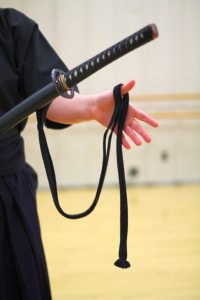 |
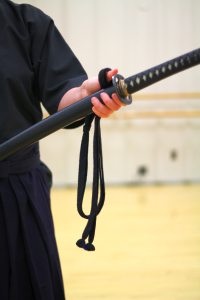 |
|
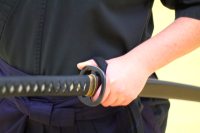 |
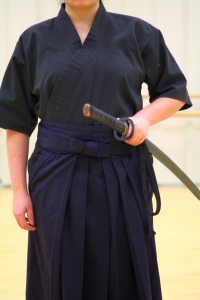 |
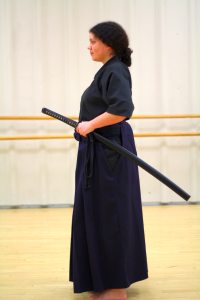 |
2. SHUTSUJO (Entering the area)
|
Proceed to the area commencing
with your right foot carrying your sword in Keito Shisei. Before
proceeding, make sure the retaining peg (Mekugi) is firmly in place,
your attire is correct and your Obi is suitably adjusted.
|
|
|
3. SHINZA E NO REI (Bow to the altar)
|
In Keito Shisei, stand upright
facing the altar. Bring the left hand across the front of the body to
the right side, around the level of the hip, changing the sword into
your right hand. Grip the cord holder (Kurigata) and the Sageo, with
your right hand. Place the blade edge down with the Tsukagashira at the
rear. Release your left hand from the sword and return it naturally to
your left side. Put the sword along your right side. Bend and incline
your upper body forwards about 30º and bow respectfully. After bowing,
bring your right hand back across the front of your body at navel
height, change hands and hold the sword guard with your left thumb and
return to Keito Shisei
|
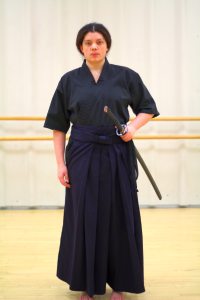
|
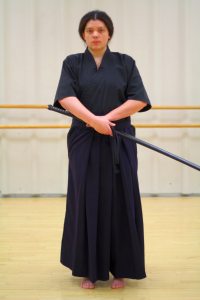
|
|
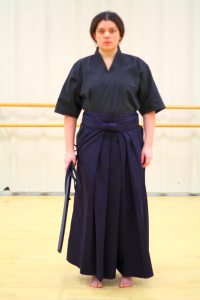
|
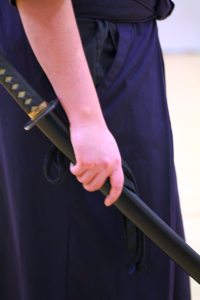
|
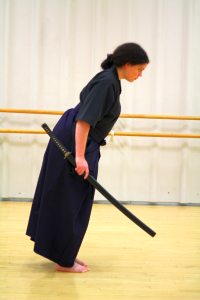
|
|
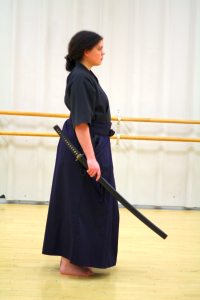
|
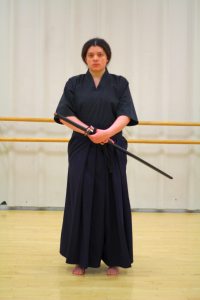 |
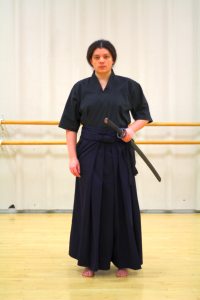 |
|
|
|
|
4. ENBU NO HOKO (Direction to face when performing)
|
Rotating your body in the
direction of your right foot, locate yourself diagonally to the right
of the altar holding your sword in Keito Shisei. You should be in a
position such that the Shinza is to your left diagonal. This direction
will become the front (Shomen) for the Enbu.
|
|
|
5. HAJIME NO TOREI (Bow to the sword before the performance)
|
From Keito Shisei, sit down (a),
place the sword to the right (b), from Seiza (c) bow to the sword (d).
|
|
|
a. CHAKUZA (Sitting down)
|
From Keito Shisei, without
withdrawing either foot, slightly open and bend both knees and while
tucking the hem of the Hakama with the palm of the right hand, place
the left knee, followed by the right on the floor. Leave about 10 cm of
space between both knees. Extend the tips of your toes and put them
side by side. Sit down comfortably. Put your right hand on the right
thigh with the fingers lightly extended. Hold the sword in your left
hand on the left thigh.
|
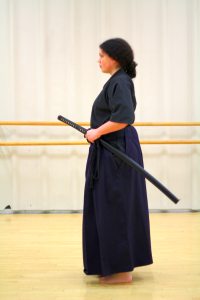
|
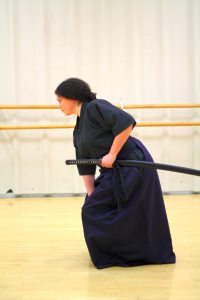
|
|
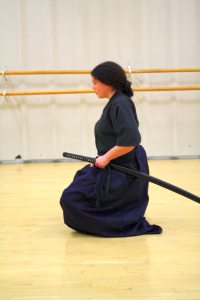
|
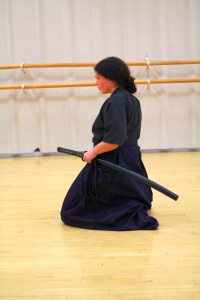
|
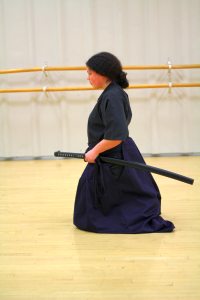
|
|
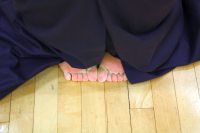 |
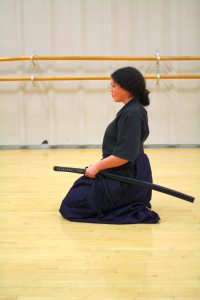 |
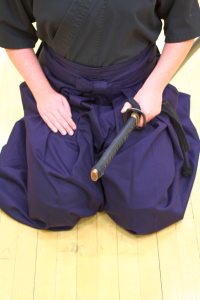 |
b. KATANA NO OKIKATA (How to place the sword)
|
With your left hand push the
sword forward until the Tsuba is in line with the center of the body.
As your right hand takes the sword, put your right thumb on the sword
guard. Hold the Saya with the other four fingers close to the Koiguchi.
Making sure the edge of the blade faces the front, extend both arms
forwards at the same time, ensuring you keep the Sageo and Saya
together. Hold near to the end of the Saya with your left hand from
above. Bend your upper body forward and lay the sword in front of you.
Be careful not to let the end of the Saya point towards the altar.
Return your upper body to its original position and put your right hand
followed by the left back on your thighs. Sit calmly in Seiza.
|
|
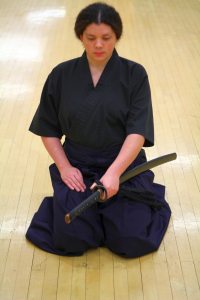 |
|
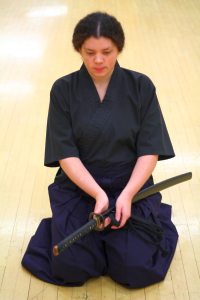 |
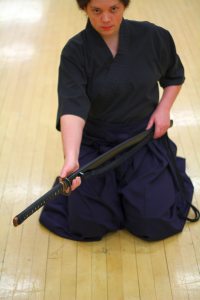 |
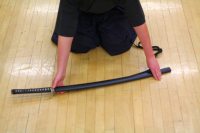 |
|
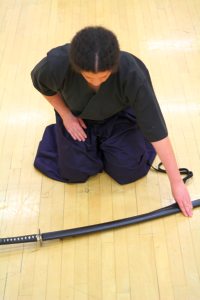 |
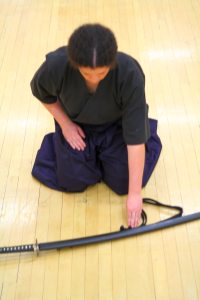 |
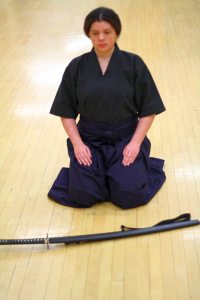 |
c. SEIZA NO SHISEI (Sitting posture)
|
Straighten your back and
concentrate your whole strength in the abdomen. Relax your shoulders
and naturally push out your chest. Straighten the back of your neck and
head. Put both hands on your thighs. Look 4-5 meters in front of you.
Half open your eyes and do Enzan No Metsuke (looking at distant
mountains). Be aware of all around you.
|
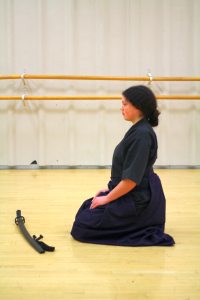 |
|
d. ZAREI (Bow)
|
Bend your upper body forward
whilst in the sitting position. Place your left hand then the right on
the floor before the sword and make a small triangle with thumbs and
forefingers touching. Continue to bow until your elbows naturally touch
the floor. Your feeling should be one of deep respect. When you have
done this, gently raise yourself up and return your right hand then
left back to your thighs.
|
|
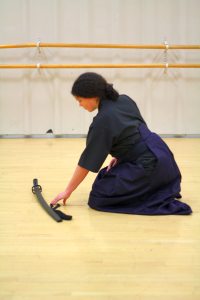 |
|
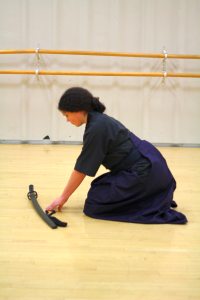 |
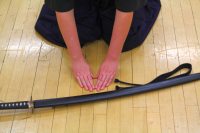 |
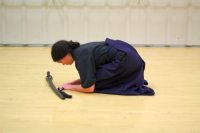 |
|
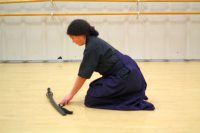 |
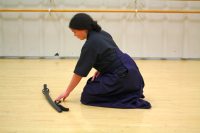 |
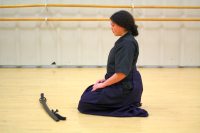 |
6. TAITO (Wearing the sword)
|
After the Hajime No Torei, you
will be spiritually united with the sword. Incline your upper body
forwards and take the sword (with Sageo) in both hands. With the right
palm up take hold of the Saya near the Koiguchi. Put the right thumb on
the sword guard and at the same time place your left hand about 10cm
from the end of the Saya and hold it lightly. As you raise yourself up
bring the tip of the Saya to the center of your abdomen and insert the
sword into the Obi. Arrange the sword so that its guard is in front of
your navel. Secure the Sageo by tying it to the Hakama and put both
hands on your thighs.
|
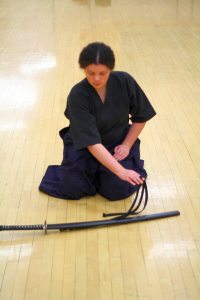
|
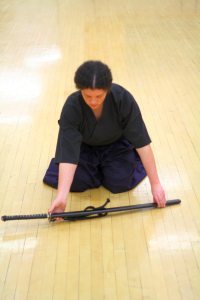 |
|
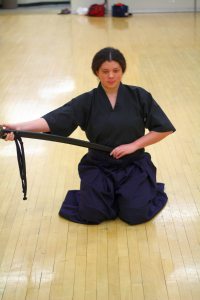
|
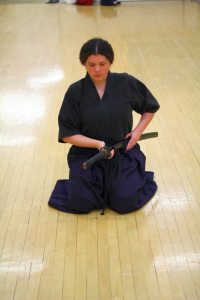
|
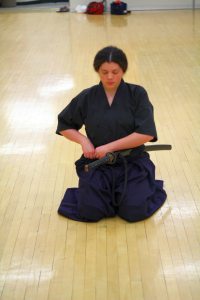
|
|
Above, Muso Shinden Ryu version 1 (sageo in
right hand, tied on right side with hands over the saya)
Next, Muso Shinden Ryu version 2
(sageo in left hand. moved to right side with right hand and tied with
hands over the saya)
|
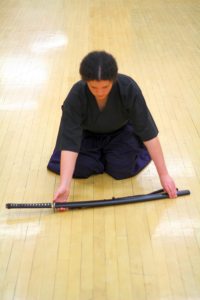 |
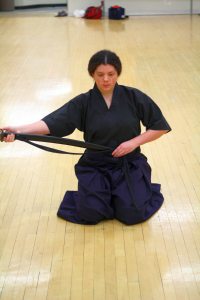
|
|
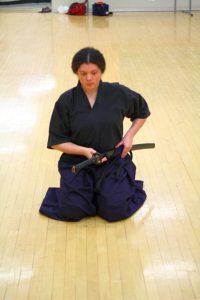
|
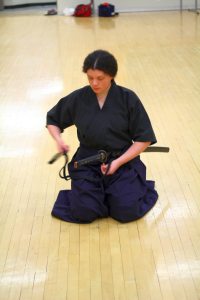
|
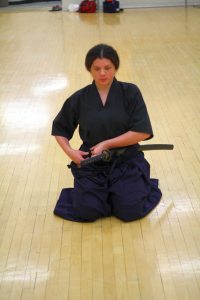
|
|
Muso
Jikiden Eishin Ryu (sageo in left hand, over the saya, tied on
the left with hands under the saya).
Three versions are presented as examples.
|
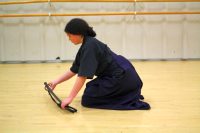 |
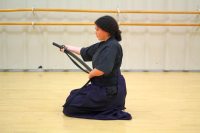 |
|
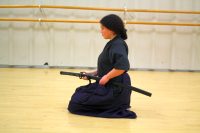 |
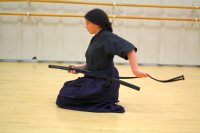 |
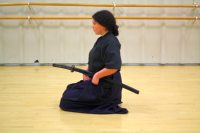 |
|
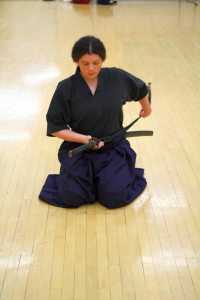 |
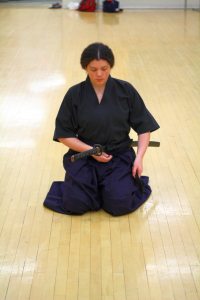
|
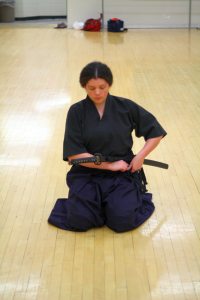
|
|
|
|
|
7. OWARI NO TOREI (Bow to the sword after the performance)
|
After completion of the Enbu,
sit in Seiza and remove the sword (a), place the sword with the handle
(Tsuka) to the left onto the floor and bow (b). Place the sword on your
thigh (c) and stand up (d).
|
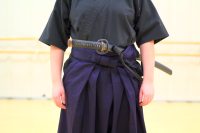
|
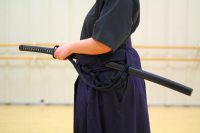
|
|
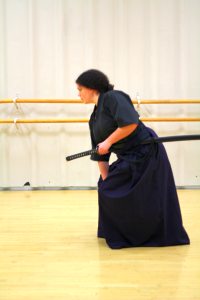
|
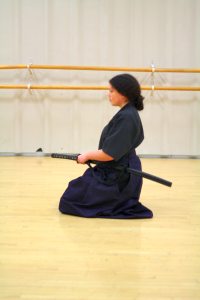
|
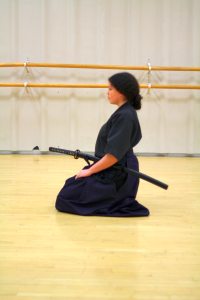
|
a. DATTO (Removing the Sword)
|
While sitting in Seiza with the
sword in the Obi, pull and release the Sageo knot with the hand only.
Place the left hand on the Saya near the Koiguchi ensuring your left
thumb is on the sword guard. Slightly push the sword forward to the
right front, a little off center. Put the right forefinger on the sword
guard and place the remaining fingers around the Koiguchi. Place your
left hand on the left side of your hip on the Obi and by extending the
right elbow, pull out the sword. Make sure that the edge of the blade
is facing you.
NOTE: tied left, then tied
right versions of sageo untying.
|
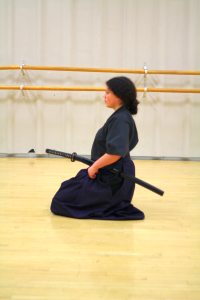
|
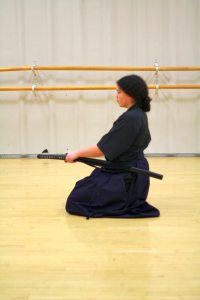
|
|
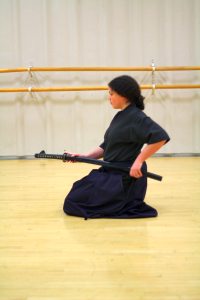
|
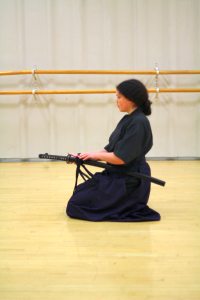
|
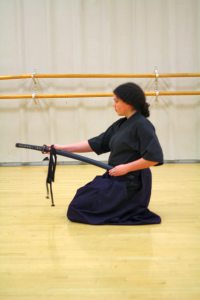
|
|
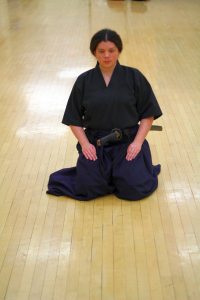
|
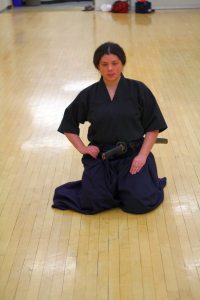
|
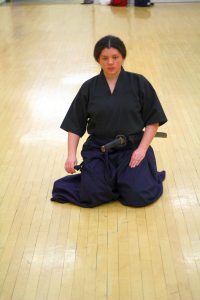
|
|
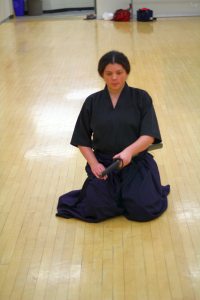
|
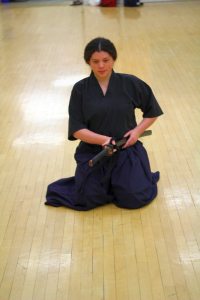
|
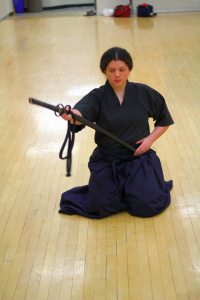
|
b. KATANA NO OKIKATA TO ZAREI (How to place the sword and bow)
|
Keeping the left hand on the
left hip, with your right hand place the sword upright on the floor at
your right front to your right knee and softly lay it down to lie in
front of you so that it appears to be horizontal. Ensure the Sageo is
tidy and that the blade edge is facing you. Put both hands on your
thighs (right then left) and take Seiza No Shisei. Perform Zarei (see
5d) and return to Seiza.
|
|
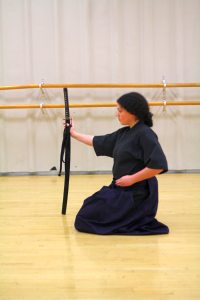
|
|
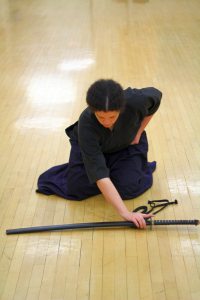
|
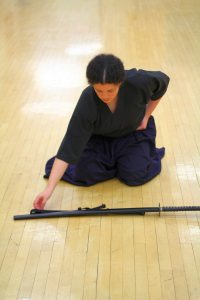
|
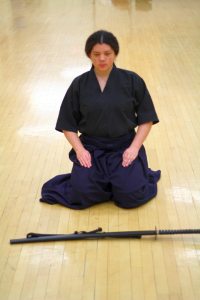
|
|
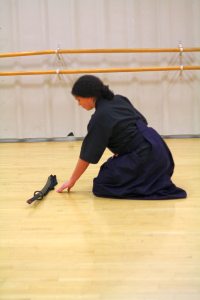
|
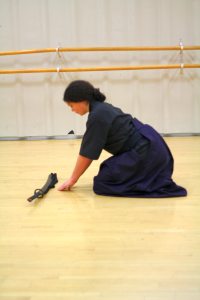
|
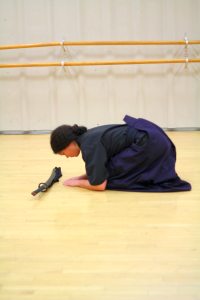
|
c. KATANA NO TORIKATA (How to take up the sword)
|
Leave your left hand on the left
thigh, stretch out your right hand and put the forefinger on the Tsuba
whilst placing the other four fingers around the Saya close to the
Koiguchi. Keeping the edge of the blade towards yourself, gently move
the sword to stand lightly at your center. Move the left hand to the
center of the Saya and squeeze it gently moving downwards to the tip.
With both hands place the sword on your left thigh.
Release your right hand from the sheath, put the left thumb on the
sword guard and grip the mouth of the Saya with the remaining fingers.
Hold the sword with your left hand and place the right hand back on
your right thigh.
|
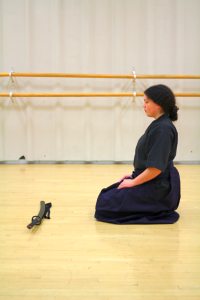
|
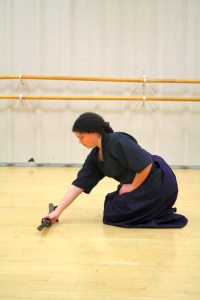
|
|
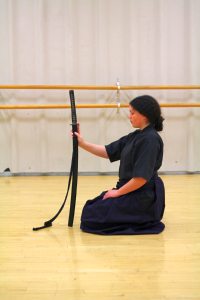
|
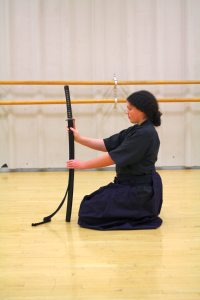
|
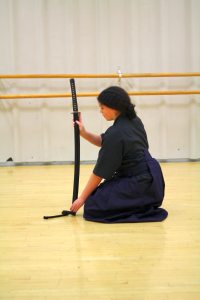
|
|
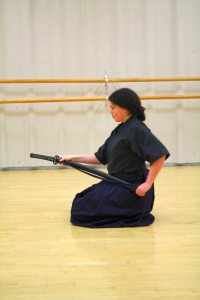
|
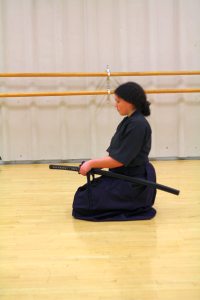
|
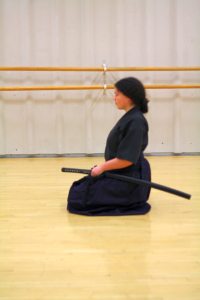
|
d. TACHI AGARI KATA (How to stand up)
|
Raise your waist up bringing
your toes underneath. Place your right foot in line with your left knee
and stand up without bending forwards. When you stand up bring your
left foot in line with the right to assume Keito Shisei.
|
|
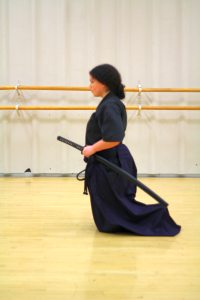
|
|
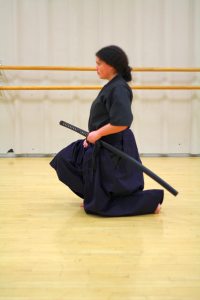
|
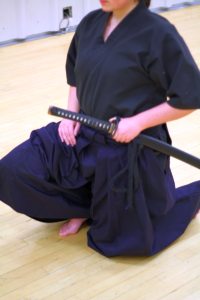
|
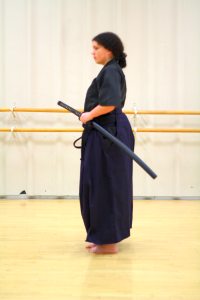
|
8. TAIJO (Leaving the area)
|
Stand in Keito Shisei and face
the altar. Pass the sword from the left hand to the right across the
front of your body and do Shinza E No Rei. Return the sword to the left
hand back into Keito Shisei. Take two or three steps back starting with
the left foot and make a 180 degree right turn and leave the area.
|
|
|
Supplement (Additional Explanations)
|
1. How to step and turn when you arrive at and leave the
Shinden area.
When you perform in the Shinden (shrine, sacred place, Dojo), you enter
the area from Shimo No Ashi (1), and leave there from Kami No Ashi (2).
When you change your direction you turn to Kami No Ashi. See diagram on
page 24. (It's actually page 41,
2009 edition)
(1) Shimo No Ashi - the foot further from the Shinza (shrine) or Shomen
(top seat). If you are on the middle line (Seichusen) it is your left
foot
(2) Kami No Ashi - the foot nearer to the Shinza or Shomen. If you are
on the middle line (Aichusen) it is your right foot.
|
Note: The etiquette described
above states that you move onto the floor
starting with the right foot and back off starting with the left. There
is, however, a supplemental section containing instructions and a
diagram of "How to step and turn in entering and leaving the Shinden
area". While there seems to be no impetus at the moment to use this
chart in gradings or practice, students might wish to examine it for
possible future need.
There are additional etiquette rules in this section that students
should read but I have not included them here. |
|
|
|
|
|
























































































